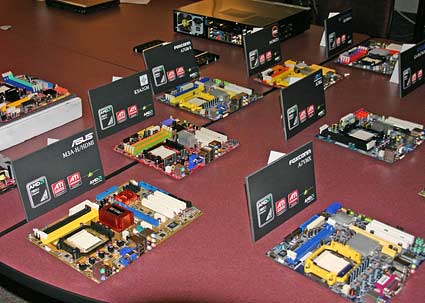Hardware News: Catch Up Today!
Conclusion
Hybrid Graphics
To compensate for the risk of selling fewer discrete cards, Eisler believes OEMs and consumers will take advantage of the new Hybrid Graphics technology. The goal of every chip manufacturer is to sell more chips every quarter, so it shouldn't be too surprising that AMD and Nvidia are linking integrated graphics chipsets with discrete graphics.
he concept itself is enticing: You can upgrade your $19 chipset with, for example, a Radeon HD 3450 graphics cards, which currently sells for about $55 in U.S. retail: AMD promises that the addition of the graphics card will more than double the graphics performance of the system. Compared to a non-hybrid graphics system with just a HD 3450 graphics card, the 780G will add about 70% of the 3450's performance.
To illustrate the performance gain, AMD claims that the above mentioned frame rates will substantially increase in a hybrid graphics environment: Crysis will see 32 fps, Call of Duty 4 73 fps, Half-Life 2 68 fps and Doom 3 60 fps.
The problem in this scenario really is that buyers of $399-$499 PCs don't upgrade their graphics, which means that OEMs will have to install the graphics cars in the first place. Margins are extremely tight in this space anyway, so why would spend an extra $30-$50 for a graphics card, especially if the 780G is already good enough to run most games and Vista?
A partial answer may be that graphics performance simply sells. And that $499 PC may not have a discrete card, but a $599 or $649 PC may have Hybrid graphics installed. Eisler believes that two out of three PCs using the 780 chipset will use the chipset only, whereas the remaining third of PCs will include an additional graphics card.
We are not sure whether it is a smart move on AMD's side to use a full R620 for the 780G chipset, which by the way is couple with the SB700 Southbridge (basically a SB600 Southbridge with lower power consumption and improved connectivity). Vendors will have a close look at this one and if they can save a few bucks, they will - no matter how great hybrid graphics is.
(Compare Prices on AMD Socket Motherboards)
Get Tom's Hardware's best news and in-depth reviews, straight to your inbox.
From the consumer view, it may be worth your while looking at those reviews and see how well the chipset stacks up against other chipsets and entry-level discrete systems. It could save you a bundle of money on your next Vista home office PC.
An interesting market for the 780G certainly is the home entertainment center PC (HTPC). If you think about those noisy boxes we have today, the idea of an entirely passively cooled system that is still capable of playing your HD movies and running a few games would be fantastic. It isn't really surprising that AMD is especially pitching this idea, even if the company has to concede that the success and failure of HTPCs will not be decided by AMD - but by companies such as Comcast and AT&T, which do not provide the bandwidth that would be necessary to support decent HTPCs, as well as most Hollywood studios, which apparently still believe consumers will pay $20 for a DRM-riddled movie download.
Technically, the 780G chipset is a great platform for a HTPC. Realistically, the HTPC will not become mainstream in 2008, no matter how badly AMD wants this to happen.
Current page: Conclusion
Prev Page Analysis: Will AMD's Chipset Graphics Game Work? Next Page AMD Demos 45 Nm ProcessorsTom's Hardware is the leading destination for hardcore computer enthusiasts. We cover everything from processors to 3D printers, single-board computers, SSDs and high-end gaming rigs, empowering readers to make the most of the tech they love, keep up on the latest developments and buy the right gear. Our staff has more than 100 years of combined experience covering news, solving tech problems and reviewing components and systems.


